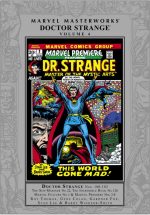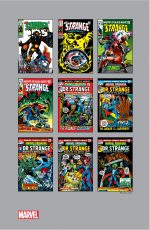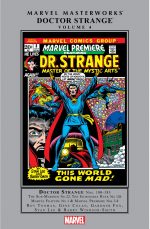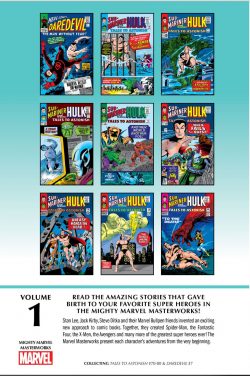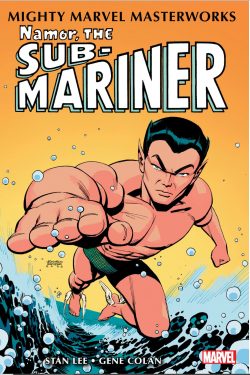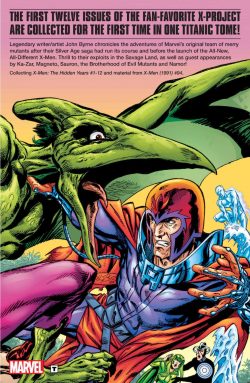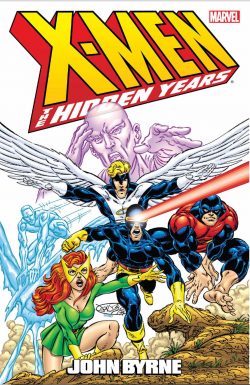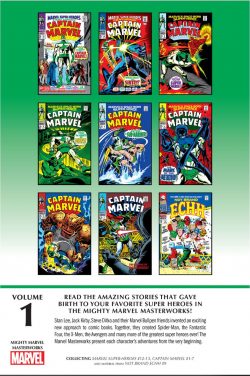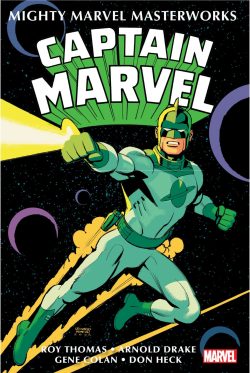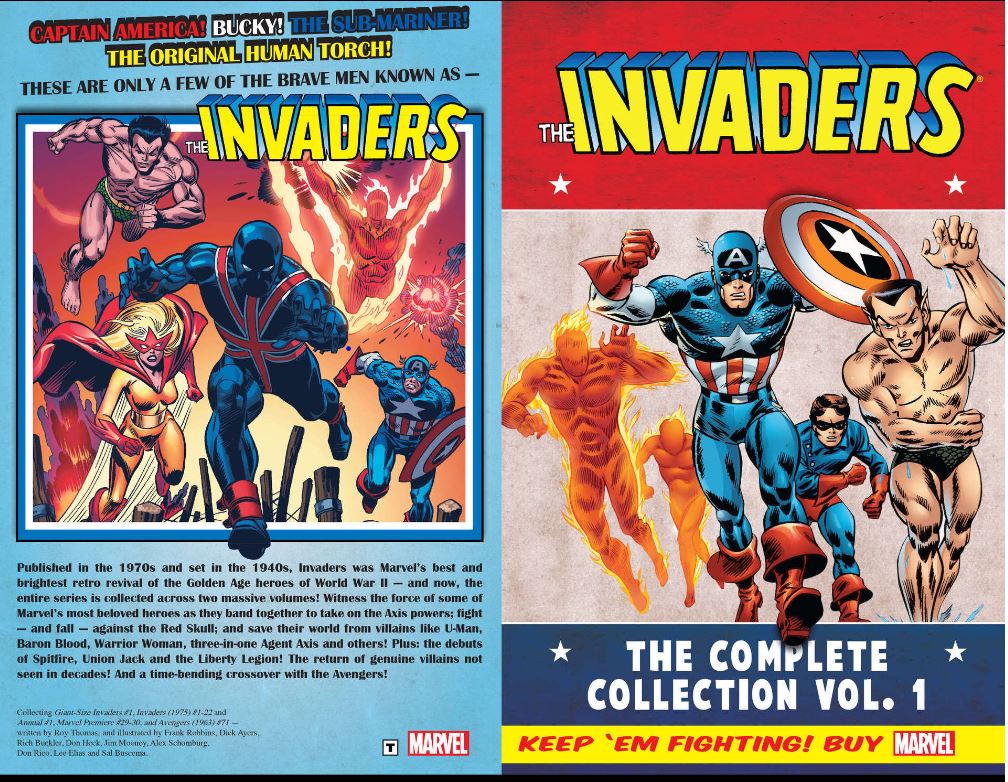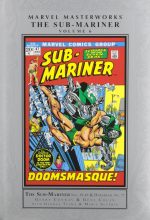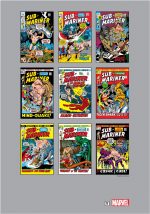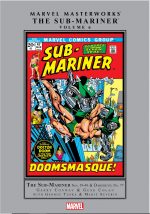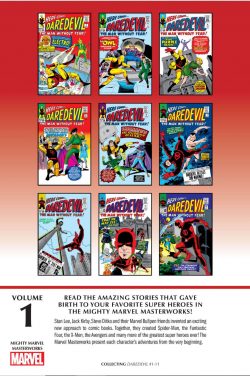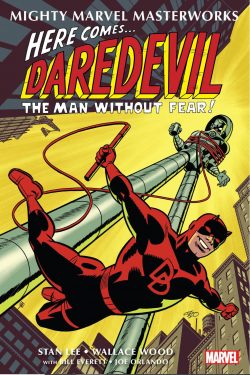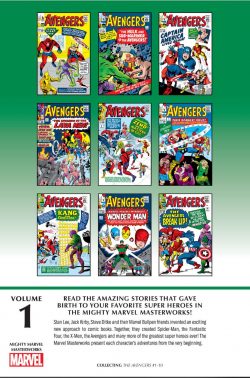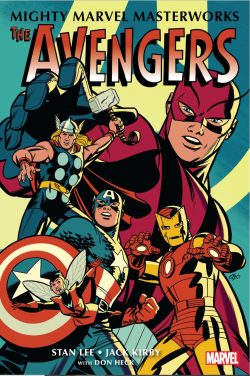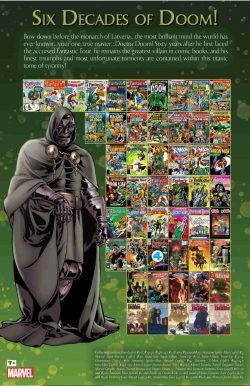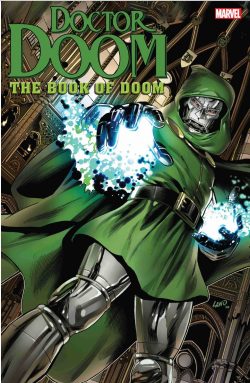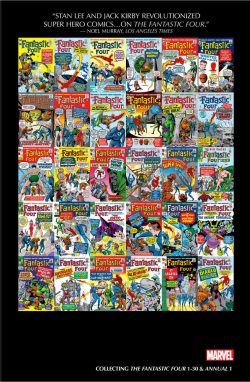
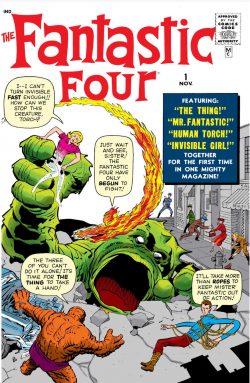
By Stan Lee & Jack Kirby with Chrisopher Rule, Steve Ditko, Dick Ayers, Joe Sinnot, George Roussos, Chic Stone, Sam Rosen, Art Simek & various (MARVEL)
ISBN: 978-0-7851-8566-6 (HB/Digital edition)
Win’s Christmas Gift Recommendation: Reliving How it All Began… 10/10
I’ve gone on record as saying that you actually can have too much of a good thing, by which I mean this collection of utter marvels is really, really heavy (and pricey) if you get the paper version. However, if you opt for electric formats, only the second quibble counts and the stories contained herein truly need to be in every home and library, so…
I’m partial to a bit of controversy so I’m going start off by saying that Fantastic Four #1 is the third most important Silver Age comic book ever, behind Showcase #4 – which introduced The Flash – and The Brave and the Bold #28, which brought superhero teams back via the creation of The Justice League of America. Feel free to disagree…
After a troubled period at DC Comics (National Periodicals as it then was) and a creatively productive but disheartening time on the poisoned chalice of the Sky Masters newspaper strip (see Complete Sky Masters of the Space Force), Jack Kirby settled into his job at the small outfit that used to be the publishing powerhouse Timely/Atlas. He churned out mystery, monster, romance and western material in a market he suspected to be ultimately doomed, but as always he did the best job possible and that genre fare is now considered some of the best of its kind ever seen.
But his fertile imagination couldn’t be suppressed for long and when the JLA caught readers’ attention it gave him and writer/editor Stan Lee an opportunity to change the industry forever.
According to popular myth, a golfing afternoon led to publisher Martin Goodman ordering nephew Stan to do a series about a group of super-characters like the JLA. The resulting team quickly took the fans by storm. It wasn’t the powers: they’d all been seen since the beginning of the medium. It wasn’t the costumes: they didn’t have any until the third issue.
It was Kirby’s compelling art and the fact that these characters weren’t anodyne cardboard cut-outs. In a real and recognizable location – New York City – imperfect, raw-nerved, touchy people banded together out of tragedy, disaster and necessity to face the incredible. In many ways, The Challengers of the Unknown (Kirby’s prototype partners in peril for National /DC) laid all the groundwork for the wonders to come, but staid, nigh-hidebound editorial strictures there would never have allowed the undiluted energy of the concept to run all-but-unregulated.
This full-colour compendium collects Fantastic Four #1-30 plus the first giant-sized Annual issues of progressive landmarks (spanning cover-dates November 1961 to September 1964) and tellingly reveals how Stan & Jack cannily built on that early energy to consolidate the FF as the leading title and most innovative series of the era.
Following a typically effusive “found footage” Foreword from Stan – with two more to follow as the many pages turn – we start with Fantastic Four #1 (tentatively bi-monthly by Lee, Kirby, George Klein & Christopher Rule) which is crude, rough, passionate and uncontrolled excitement. Thrill-hungry kids pounced on it.
‘The Fantastic Four’ saw maverick scientist Reed Richards summon his fiancée Sue Storm, their close friend Ben Grimm and Sue’s teenaged brother before heading off on their first mission. They are all survivors of a private space-shot that went horribly wrong when Cosmic Rays penetrated their ship’s inadequate shielding and mutated them all.
Richards’ body became elastic, Sue gained the power to turn invisible, Johnny Storm could turn into living flame and tragic Ben turned into a shambling, rocky freak. In ‘The Fantastic Four meet the Mole Man’ they quickly foil a plan by another outcast who controls monsters and slave humanoids from far beneath the Earth. This summation of the admittedly mediocre plot cannot do justice to the engrossing wonder of that breakthrough issue – we really have no awareness today of how different in tone, how shocking it all was.
“Different” doesn’t mean “better” even here, but the FF was like no other comic on the market at the time and buyers responded to it hungrily. The brash experiment continued with another old plot in #2. ‘The Skrulls from Outer Space’ were shape-changing aliens who framed the FF in the eyes of shocked humanity before the genius of Mister Fantastic bluffed them into abandoning their plans for conquering Earth. The issue concluded with a monstrous pin-up of the Thing, proudly touted as “the first of a series…”
Sure enough, there was a pin-up of the Human Torch in #3, which headlined ‘the Menace of the Miracle Man’ (inked by Sol Brodsky), whose omnipotent powers had a simple secret, but is more notable for the first appearance of their uniforms, and a shocking line-up change, leading directly into the next issue (continued stories were an innovation in themselves) which revived a golden-age great.
‘The Coming of the Sub-Mariner’ reintroduced an all-powerful amphibian Prince of Atlantis and star of Timely’s Golden Age but one who had been lost for years. A victim of amnesia, the relic recovered his memory thanks to some rather brusque treatment by the delinquent Human Torch. Namor then returned to his sub-sea home only to find it destroyed by atomic testing. A monarch without subjects, he swore vengeance on humanity and attacked New York City with a gigantic monster. This saga is when the series truly kicked into high-gear with Mister Fantastic as the pin-up star.
Until now the creative team – who had both been in the business since it began – had been hedging their bets. Despite the innovations of a contemporary superhero experiment, their antagonists had relied heavily on the trappings of popular trends in other media – and as reflected in their other titles. Aliens and especially monsters played a major part in earlier tales but Fantastic Four #5 took a full-bite out of the Fights ‘n’ Tights apple by introducing the first full-blown super-villain to the budding Marvel Universe.
No, I haven’t forgotten Mole Man: but that tragic little gargoyle, for all his plans of world conquest, wouldn’t truly acquire the persona of a costumed foe until his more refined second appearance in #22.
‘Prisoners of Doctor Doom’ (July 1962, and inked by subtly sleek Joe Sinnott) has it all. An attack by a mysterious enemy from Reed’s past; magic and super-science, lost treasure, time-travel, even pirates. Ha-Haar, me ’earties!
Sheer magic! And the creators knew they were on to a winner since the deadly Doctor was back in the very next issue, teamed with a reluctant Sub-Mariner to attack our heroes as ‘The Deadly Duo!’ – and inked by new regular embellisher Dick Ayers.
Alien kidnappers were behind another FF frame-up resulting in the team briefly being ‘Prisoners of Kurrgo, Master of Planet X’: a dark and grandiose off-world thriller in #7 (the first monthly issue), whilst a new returning villain and the introduction of a love-interest for monstrous Ben Grimm were the breakthrough high-points in #8’s ‘Prisoners of the Puppet Master!’ The saga was topped off with a Fantastic Four Feature Page explaining how the Torch’s powers work. The next issue offered another detailing with endearing mock-science ‘How the Human Torch Flies!’
That issue, #9, trumpeted ‘The End of the Fantastic Four’ as Sub-Mariner returned to exploit another brilliant innovation in comic storytelling. When had a supergenius superhero ever messed up so much that the team had to declare bankruptcy? When had costumed crime busters ever had money troubles at all? The eerily prescient solution was to “sell out” and make a blockbuster movie – giving Kirby a rare chance to demonstrate his talent for caricature… and prescience…
1963 was a pivotal year in Marvel’s development. Lee & Kirby had proved their new high concept – human heroes with flaws and tempers – had a willing audience. Now they would extend that ideation to a new pantheon of heroes. Here is where the second innovation would come to the fore.
Previously, superheroes were sufficient unto themselves and shared adventures were rare. Now and here, however, was a universe where characters often and literally stumbled over each other, sometimes even fighting other heroes’ enemies! The creators themselves might turn even up in a Marvel Comic! Fantastic Four #10 featured ‘The Return of Doctor Doom!’ wherein the arch villain used Stan and Jack to lure the Richards into a trap where his mind is switched with the bad Doctor’s. The tale is supplemented by a pin-up of ‘Sue Storm, the Glamorous Invisible Girl’ and another Lee Foreword…
Innovations continued in #11, with two short stories instead of the usual book-length yarn, opening with behind-the-scenes travelogue/origin tale ‘A Visit with the Fantastic Four’ with a stunning pin-up of Sub-Mariner segueing into baddie-free, compellingly comedic vignette. ‘The Impossible Man’ was like superhero strip ever seen before.
Cover-dated March 1963, FF #12 featured an early landmark: arguably the first Marvel crossover as the team are asked to help the US army capture ‘The Incredible Hulk’: a tale of intrigue, action and bitter irony. The argument comes as Amazing Spider-Man #1 (not included here) – wherein the arachnid tries to join the team – has the same release date… Fantastic Four #13’s ‘Versus the Red Ghost and his Incredible Super Apes!’ is a Cold War thriller pitting the quartet against a Soviet scientist in the race to reach the Moon: and notable both for its moody Steve Ditko inking (replacing Ayers for one glorious month) and the introduction of cosmic voyeurs The Watchers.
‘The Sub-Mariner and the Merciless Puppet Master!’ unwillingly co-star in #14, with one vengeful fiend the unwitting mind-slave of the other, followed by ‘The Mad Thinker and his Awesome Android!’, embarking upon a chilling war of intellects between driven super-scientists but with plenty of room for all-out action. After a notable absence, pin-ups resume with a candid group-shot of the team.
Fantastic Four #16 reveals ‘The Micro-World of Doctor Doom!’ in a spectacular romp guest-starring new hero Ant-Man plus a Fantastic Four Feature Page outlining the powers and capabilities of elastic Mister Fantastic. Despite a resounding defeat, the steel-shod villain returns with more infallible, deadly traps a month later in ‘Defeated by Doctor Doom!’, before FF #18 heralds a shape-changing alien who battles the heroes with their own powers when ‘A Skrull Walks Among Us!’: a prelude to greater, cosmos-spanning sagas to come…
The wonderment intensifies with the first Fantastic Four Annual: a spectacular 37-page epic by Lee, Kirby & Ayers as – finally reunited with their wandering prince – warriors of Atlantis invade New York City (and the world) in ‘The Sub-Mariner versus the Human Race!’.
A monumental tale by the standards of the time, it saw the FF repel the undersea invasion through valiant struggle and brilliant strategy whilst providing a secret history of the secretive race Homo Mermanus. Nothing was really settled except a return to a former status quo, but the thrills were intense and unforgettable…
Also included are rousing pin-ups and fact file features. The Mole Man, Skrulls, Miracle Man, Sub-Mariner, Doctor Doom, Kurrgo, Puppet Master, Impossible Man, The Hulk, Red Ghost and his Super-Apes, and Mad Thinker comprise ‘A Gallery of the Fantastic Four’s Most Famous Foes!’, whilst ‘Questions and Answers about the Fantastic Four’, and a diagrammatic trip ‘Inside the Baxter Building’ evoke awe wonder and understanding. Short story ‘The Fabulous Fantastic Four Meet Spider-Man!’ then reexamines in an extended re-interpretation that first meeting from the premiere issue of the wallcrawler’s own comic. Pencilled this time by Kirby, the dramatic duel benefitted from Ditko’s inking which created a truly novel look.
Cover-dated October 1963, Fantastic Four #19 premiered another of the company’s major villains as the quarrelsome quartet travelled back to ancient Egypt and ‘Prisoners of the Pharaoh!’ This time travel tale has been revisited by so many writers that it is considered one of the key stories in Marvel history introducing a future-Earth tyrant who would evolve into overarching menace Kang the Conqueror.
Another universe-threatening foe was introduced and defeated by brains not brawn in FF#20 when ‘The Mysterious Molecule Man!’ menaced New York before being soundly outsmarted, after which one last Lee Foreword precedes another cross-pollination: this time guest-starring Nick Fury, lead character in Marvel’s only war comic.
Sgt. Fury and his Howling Commandos was another solid hit, but eventually its brusque and brutish star metamorphosed into Marvel’s answer to James Bond. Here, however, he’s a cunning CIA agent seeking the team’s aid against a sinister demagogue called ‘The Hate-Monger’: a cracking yarn with a strong message, inked by comics veteran George Roussos, under the protective nom-de-plume George Bell.
By this juncture the FF were firmly established and Lee & Kirby well on the way to toppling DC/National Comics from a decades-held top spot through an engaging blend of brash, folksy and consciously contemporaneous sagas: mixing high concept, low comedy, trenchant melodrama and breathtaking action.
Unseen since the premiere issue, #22 saw ‘The Return of the Mole Man!’ in another full-on monster-mashing fight-fest, chiefly notable for debuting Sue Storm’s new powers of projecting force fields of “invisible energy.” This advance would eventually make her one of the mightiest characters in Marvel’s pantheon.
Fantastic Four #23 enacted ‘The Master Plan of Doctor Doom!’, by introducing mediocre minions “the Terrible Trio” – Bull Brogin, Handsome Harry and Yogi Dakor – and the uncanny menace of “the Solar Wave” (which was enough to raise the hackles on my 5-year-old neck. Do I need to qualify that with: all of me was five, but only my neck had properly developed hackles back then?)…
In #24’s ‘The Infant Terrible!’ is a sterling yarn of inadvertent extragalactic menace and misplaced innocence, followed by a 2-part tale truly emphasising the inherent difference between Lee & Kirby’s work and everybody else’s at that time.
Fantastic Four #25-26 featured a cataclysmic clash that had young heads spinning in 1964 and led directly to the Emerald Behemoth finally regaining a strip of his own. In ‘The Hulk vs The Thing’ and ‘The Avengers Take Over!’, a relentless, lightning-paced, all-out Battle Royale results when the disgruntled man-monster returns to New York in search of side-kick Rick Jones, with only an injury-wracked FF in the way of his destructive rampage.
A definitive moment in The Thing’s character development, action ramps up to the max when a rather stiff-necked and officious Avengers team horn in, claiming jurisdictional rights on “Bob” Banner (this tale is plagued with pesky continuity errors which would haunt Stan Lee for decades) and his Jaded alter ego. Notwithstanding bloopers, this is one of Marvel’s key moments and still a visceral, vital read.
Stan & Jack had hit on a winning formula by including other stars in guest-shots – especially since readers could never anticipate if they would fight with or beside the home team. FF #27’s ‘The Search for Sub-Mariner!’ again saw the undersea antihero in amorous mood, and when he abducts Sue the boys call in Doctor Strange, Master of the Mystic Arts to locate them. Issue #28 was another terrific team-up, but most notable (for me and many other fans) for the man who replaced George Roussos…
‘We Have to Fight the X-Men!’ sees the disparate super-squads in conflict due to the Mad Thinker and Puppet Master’s malign machinations, but the inclusion of Chic Stone – Kirby’s most simpatico and expressive inker – elevates the illustration to indescribable levels of beauty.
‘It Started on Yancy Street!’ (FF #29) starts low-key and a little bit silly in the slum where Ben Grimm grew up, but with the reappearance of the Red Ghost and his Super-Apes, it all goes Cosmic, resulting in a blockbusting battle on the Moon, with the following issue – and last saga here – introducing evil alchemist ‘The Dreaded Diablo!’ – who briefly breaks up the team while casually conquering the world from his spooky Transylvanian castle….
To Be Continued…
Bolstered by all Kirby’s covers, every ‘Fantastic 4 Fan Page’ (with letters from adoring fans many here will recognise), Lee’s concluding essay ‘Reflections on the Fantastic Four’ and appreciations from Paul Gambaccini, Tom DeFalco and Roy Thomas, the joy concludes with added attractions including Lee’s original synopsis for FF #1, a selection of house ads, unused pages and cover art for #3, #20 and Annual #1.
This is a truly magnificent book highlighting pioneering tales that built a comics empire. The verve, imagination and sheer enthusiasm shines through and the wonder is there for you to share. If you’ve never thrilled to these spectacular sagas then this book of marvels is your best and most economical key to another world and time.
© 2022 MARVEL.

